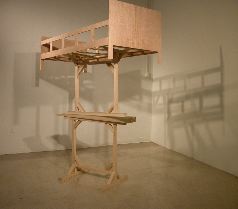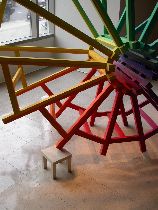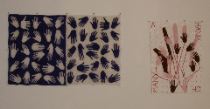
I ran in to Rosenwald Wolf Gallery the other day to see Wade Saunder‘s work before heading over to the ICA. The first thing I thought when I wandered around the wooden objects stacked on top of each other like odd displays in a furniture showroom was, hmm. Somebody’s scared of a mouse, eek. (image is “Goodnight Moon” a bed atop two stacked sets of table legs)
Then again, the jumble of wood objects fleeing the floor felt like possessions stacked up to evade flood water in a house — or even possessions on a curb from a tenant who’s been evicted.

Saunders’ pile-ups of hand-made domestic objects like beds and chairs (the show’s called “Domestic Life”) are loaded with emotional baggage. Place one chair atop another and it’s automatically an equation about one person carrying the weight of another. Or maybe it’s about distribution of responsibility or the fight for dominance in a relationship. In all cases the affect is contradictory — one of elegance made inelegant, balance become imbalanced, possessions made dispossessed. (right is “Hub and Spokes,” a piece that rests on an improbably small and color-less table.)
The artist constructed the pieces himself at UArts *with the assistance of Tony Darnell. According to Sid Sachs, Gallery Director, without Darnell’s technical skill and input it would have taken Saunders a lot longer to produce the work. Darnell is acknowledged as such in the show’s brochure. The pieces are not off the shelf from a store. He made them to look like store-bought chairs and beds but jiggered their proportions making, for example, the legs of a sawhorse too skinny or the frame of a chair way too thick. By tinkering with proportions the artist signaled his leap into symbol and metaphor and allowed the viewer to leave the literal world behind. For viewers with a formalist sensibility, the works might seem a series of squares and stripes and sticks piled up in a Malevich-like arrangement. But for me the work was never not chairs and tables and real world objects piled high. By the way, the artist didn’t use fasteners to make his piles. The modules are simply interlocked of their own and the artist’s volition.
[*ed. note: This paragraph has been corrected. It previously said that Saunders made the work himself. Saunders actually made the work with the help and expertise of Tony Darnell. I apologize for the ommission.]
Saunders, who lives in Paris has a Philadelphia connection. Gallery Director Sid Sachs told me the artist taught at Tyler School of Art back in the day and that his work was shown around Philadelphia as well. Here’s a link to a group show he was in at Moore College in 1987. Allan McCollum was in the show as well. Later on, Saunders, who is also a writer, did an interview with McCollum about the artist’s use of studio assistants. Here’s the interview.

A small part of the show includes small wall hangings that are graphic designs by the artist which were translated into beadwork pieces. Sachs told me Saunders jobbed the work out to some people in India. I was very uneasy with them once I got that bit of information. The works are labor-intensive and the whole thing seemed a little too Western-designed but Third World Country manufactured for me. (shown is a “A Common Alphabet” — the piece with all the hands and another from the series)
The show’s a cool character for work dealing with emotions and domestic issues. If emotional terrain is being plowed, I like a little scorched earth in the bargain. I couldn’t help feeling that somehow the artist pulled his punches a little.
The exhibit is up until May 15.









